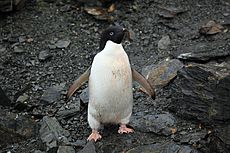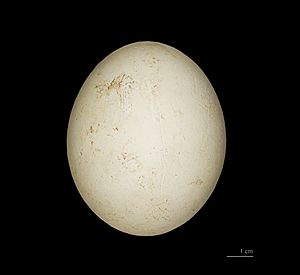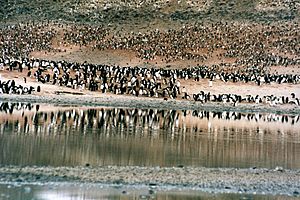Adélie penguin facts for kids
Quick facts for kids Adélie penguin |
|
|---|---|
 |
|
| An Adélie penguin | |
| Conservation status | |
| Scientific classification | |
| Kingdom: | |
| Phylum: | |
| Class: | |
| Order: | |
| Family: | |
| Genus: |
Pygoscelis
|
| Species: |
P. adeliae
|
| Binomial name | |
| Pygoscelis adeliae (Hombron and Jacquinot, 1841)
|
|
The Adélie penguin (Pygoscelis adeliae) is a type of penguin that lives in Antarctica. These penguins have a black head and back. Their chest and belly are white. They also have a clear white ring around each of their eyes.
This penguin was named after Adélie Land. This land was named by French explorer Jules Dumont d'Urville in 1840. He named it after his wife, Adèle Dumont d'Urville. Dumont d'Urville was the first to discover this penguin.
Adélie penguins find their food by hunting and searching. They mostly eat small sea creatures like krill and fish. There are about 2.5 million Adélie penguins living in the Southern Ocean near Antarctica.
Adélie penguins travel very far to find places to build their nests. They build their nests from stones. They come to shore to breed in the summer. In the winter, they live on ice that floats off the Antarctic coast.
Contents
About Adélie Penguins
Adélie penguins are the smallest penguins in Antarctica. They weigh about 3.8 kilograms (8.5 pounds). This is similar to the weight of a typical house cat. They are about 71 centimeters (28 inches) tall.
Male and female Adélie penguins look very similar. However, females have shorter wings and beaks. They also weigh less than males. Adult penguins have a black head, throat, and upper body. Their underparts are snowy white.
They have a clear white ring around their black eyes. Most of their beak is covered with black feathers. Only the tip is showing. This tip is mostly black, but it can have reddish-brown marks. Their legs and feet are pinkish and mostly without feathers.
Penguin Chicks
When a chick hatches, it is covered in soft down feathers. This first coat is usually silvery-grey. The head is often darker. Within 10 days, the chick grows a new set of down feathers. These are all dark smoky-grey.
After 7 to 9 weeks, they grow their third set of feathers. At this point, young penguins look like adults. But they are usually smaller. Their upper parts might look a bit bluer. Their chin and throat are white, not black. They don't get the full white eye ring until they are at least one year old.
How They Compare to Other Penguins
It's easy to tell an adult Adélie penguin apart from other penguins. But a young Adélie penguin with a white throat can look like a chinstrap penguin.
However, the black on an Adélie's face goes below its eyes. It also doesn't have the black line under its throat that a chinstrap penguin has. The chinstrap penguin's beak is longer. It also doesn't have feathers covering most of it, like the Adélie's beak does.
Where Adélie Penguins Live
The Adélie penguin is a true Antarctic animal. It is one of only four penguin species that nest on the continent itself. Their breeding groups are found along Antarctica's coasts. They also live on some islands near Antarctica. These include the South Orkney Islands, South Shetland Islands, South Sandwich Islands, Balleny Islands, Scott Island, and South Georgia.
These penguins are not common north of 60°S latitude. But some have been seen in Australia, New Zealand, and southern South America. During the breeding season, they need bare, rocky ground for their nests. They do not nest on ice. They prefer areas where wind or sun helps keep snow away. At the start of breeding, their nesting sites can be up to 100 kilometers (60 miles) from open water. This distance gets shorter as summer goes on and the ice breaks up.
After breeding, adult Adélie penguins usually move to ice floes or ice shelves to shed their old feathers. Some stay on shore. In winter, they stay in the pack ice zone. Most move north to find areas with sunlight for at least part of the day. This means they go north of about 73°S. Some stay near their breeding colonies. Others may travel hundreds or thousands of kilometers away. They can survive hundreds of kilometers south of open water if there are breaks in the ice. They are known to find food in winter even in areas with a lot of ice.
Penguin Behavior
People who have studied Adélie penguins have learned a lot about their behavior. One explorer, Apsley Cherry-Garrard, wrote about them. He said they are "extraordinarily like children."
Another scientist, George Murray Levick, saw how penguins sometimes acted selfishly. He watched them near a tall ice edge. Many penguins would gather there. They would push one penguin over the edge. Then, they would all look down. If the first penguin was safe in the water, the rest would follow.
Sometimes, the penguins' curiosity could put them in danger. They would waddle towards howling dogs, not understanding the danger. They seemed to think it was a game. This often led to sad outcomes for the curious penguins.
However, others on the expeditions admired their curiosity. Cherry-Garrard wrote about a penguin that saw dog teams. The penguin thought the dogs' barking was a greeting. It hurried to meet them. A man had to save the penguin from danger. The penguin was very angry about being saved!
Cherry-Garrard greatly respected these birds. He felt that everything a penguin does shows its unique personality. He said they "lay bare his whole life for all to see." He admired their bravery in facing tough challenges.
Adélie penguins are known for being bold and lively. They will even challenge much larger animals, including predators. In a documentary, an Adélie penguin was seen chasing away a large Southern giant petrel. This petrel was threatening some emperor penguin chicks. This shows how brave Adélie penguins can be.
Adélie penguins usually swim at about 8 kilometers per hour (5 miles per hour). They can leap about 3 meters (10 feet) out of the water. They do this to land on rocks or ice.
What Adélie Penguins Eat
Adélie penguins mostly eat Antarctic krill, ice krill, and Antarctic silverfish. They also eat sea krill and glacial squid. Their diet changes depending on where they are.
Scientists have studied old penguin eggshells. These show that about 200 years ago, Adélie penguins suddenly changed their diet. They used to eat mostly fish. Now they eat mostly krill. This change likely happened because there were fewer Antarctic fur seals and baleen whales. These animals also eat krill. With less competition, there was more krill available for the penguins.
Adélie penguins have also been found to actively seek out jellyfish as food. Before, people thought they only ate jellyfish by accident. Other penguin species, like the little penguin and yellow-eyed penguin, also eat jellyfish.
How They Travel
Adélie penguins in the Ross Sea region travel very far each year. They migrate about 13,000 kilometers (8,000 miles) on average. They follow the sun from their breeding places to their winter feeding grounds and back.
In winter, the sun does not rise south of the Antarctic Circle. But sea ice grows during winter. It spreads for hundreds of miles from the shore, reaching more northern areas around Antarctica. As long as the penguins stay at the edge of this ice, they will see sunlight. As the ice melts in the spring, the penguins stay at its edge. This continues until they are back on the shoreline during the sunnier season. The longest journeys recorded have been 17,600 kilometers (10,900 miles).
Dangers to Adélie Penguins
Adult Adélie penguins are often hunted by leopard seals. Large birds like South polar skuas and Giant petrels kill many chicks and eat eggs. Giant petrels and orcas sometimes kill adult Adélie penguins. Other birds like Kelp gulls and snowy sheathbills also prey on chicks and eggs.
Conservation Status
The Adélie penguin population is very large and growing. In 2020, there were more than 10 million adult penguins. Their habitat is also not broken up. Because of this, the International Union for the Conservation of Nature considers the Adélie penguin a species of Least Concern. This means they are not currently at risk of extinction.
Chicks and Eggs
Adélie penguin parents take turns caring for their chicks. One parent stays at the nest to keep the chicks warm and safe. The other parent goes into the ocean to catch krill. The penguins carry the krill back to the nest in their stomachs. Then, they regurgitate it to feed their chicks.
Most Adélie penguins incubate two eggs at a time. The little chicks hatch out around the same time. One chick is usually stronger than the other. This stronger chick often has a better chance of surviving.
When they are first born, the chicks are kept warm by their parents. But after two or three weeks, they grow a thick, woolly gray down. Then, they join other chicks in groups called creches, or nursery groups.
Images for kids
-
Mating in Antarctica
-
Stuffed chick at Auckland Museum
See also
 In Spanish: Pingüino de Adelia para niños
In Spanish: Pingüino de Adelia para niños








